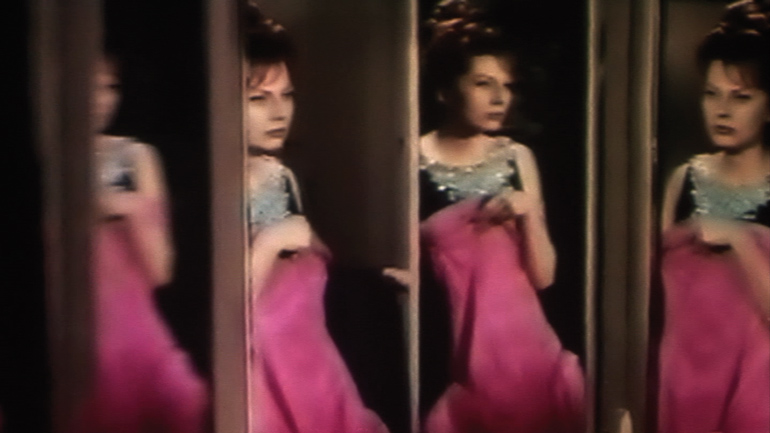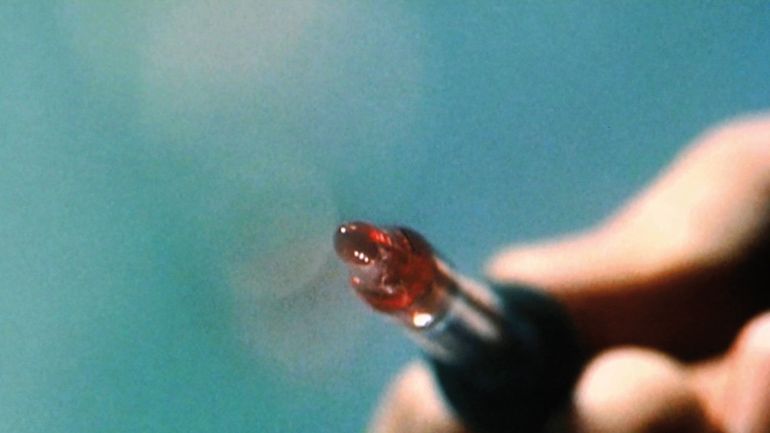THE FILMS OF CHRISTOPH GIRARDET AND MATTHIAS MÜLLER
Christoph Girardet, Matthias Müller (photo © Kristina Tieke)IN the vast array of film genres, from mainstream to experimental, you may be forgiven for thinking that the area of work that uses ’found footage’ could be considered redundant, especially in a post-YouTube world filled with mash-ups, parodies and digital manipulation. And yet, while the work of Christoph Girardet and Matthias Müller has its basis in such a methodology, it has long been recognized as being far more profound and prescient than the mere pick ’n’ mix trappings of pop culture.
With their partnership now in its sixteenth year — long predating the digital zeitgeist – Christoph Girardet and Matthias Müller’s names have become a common sight in the lists of the prize winners and critically-acclaimed on the international experimental festival circuit. Their films often contain painstakingly edited and researched footage, taken from the vast wealth of 20th century filmmaking and re-contextualized to tease out new meanings and emotions. The co-creators’ explore these darker or concealed aspects of film language, often unveiling hidden meanings by the random juxtaposition of similar themes such as childhood (METEOR, 2011), sight and perception (CONTRE-JOUR, 2009 and MAYBE SIAM, 2009), memory (BEACON, 2002), bodily mutilation (CUT, 2013), or travel (LOCOMOTIVE, 2008).
And yet Girardet and Müller are more than merely dry formalists, curating what has gone before. Far from being a sterile evisceration of classic tropes and clichés, their work uses technical skill and an almost encyclopaedic knowledge of the classics to create poignant commentary on longing, space and mystery, often delivered with barbed humor that belies the arena in which they operate. As Girardet says: “The absence of a narrative (in a literary manner) doesn’t necessarily mean the absence of dramaturgy or structure. So I wouldn’t call this formalism.”
The pair’s early solo works shared a predilection for similar working methods — a ’horizontal’ rather than traditional ’linear’ approach’ to a film’s narrative arc. A simplified overview of solo both past and present work might point to Girardet’s films demonstrating more technical panache and a sense of ’space’ or silence. His SIXTY SECONDS (2002) combines tiny clips of the second hands of watches to mark out a minute in real time; pre-dating Christian Marclay’s notorious THE CLOCK by nearly a decade. Meanwhile, work such as PIANOFORTE (2007) or ABSENCE (2002) compile classic Hollywood footage, paired with his own personal interest in minimalism, to draw the viewer into the work’s enigmatic silences. Conversely, Müller’s early works such as SLEEPY HAVEN (1994) or HOME STORIES (1990) convey a far more acute sense of personal narrative, often relying on spoken word accompaniment or even amateur found footage in their explorations of sexuality and relationships.

Scene from KRISTALL (photo © Christoph Girardet, Matthias Müller)
Their working relationship was born in 1999 when Müller was called upon to contribute to a major group show exploring Hitchcock’s impact on contemporary art and realized that the workload (and the themes) involved demanded the contributions of a second artist. This first work, PHOENIX TAPES, was a sextet of themed shorts, each using repeated motifs from the master’s catalogue to highlight the language of symbols and gestures used repeatedly by Hitchcock as well as creating a newer language entirely their own.
Indeed, it’s important to the duo that the precision and expertise used in compiling these short films never manages to obscure the personal themes and more emotional aspects reflected in the work. Müller says: “There’s a lot of talking before we decide on a theme, and whatever subject we chose is based on the intersection of our personal experiences. No matter how visible they are: those personal issues are more than a backdrop to our artistic practice; they deeply influence any artistic decision made. However, both of us need to be affected and to feel challenged by the matters addressed by us to a similar extent.”

Scene from CONTRE-JOUR (photo © Christoph Girardet, Matthias Müller)
Girardet and Müller’s work can work its magic on the viewer in several subtle and ingenious ways. The cumulative effect of repetition and reiteration can simulate dream states, while often the links between the pieces of found footage lead one through an ever-changing narrative thread that unfolds like a maze.
“This portrayal also demands repeated viewings, which explains why you’re equally likely to see the pair’s work represented within the more contemplative surroundings of European art galleries as in a screening room: their work has featured in many major international exhibitions including, in 2014, a huge retrospective at Hannover’s Kunstverein: Tell Me What You See. As Müller himself explains, this appreciation of their work in a less hectic context is crucial to a truer understanding: “It obviously needs repeated viewing to figure this out; a single festival screening is just not enough. This is one reason why we like to have our work displayed in galleries and museums: this context invites viewers to revisit works already watched. To me, this also says something about the ongoing crisis of film criticism: professional critics are being underpaid… they need to produce a lot to survive. Dense, disparate and complex works such as ours, films that offer multiple readings, are easily reduced to one simple alleged theme in this situation. The most rewarding and thoughtful reviews and indepth explorations we have received lately were either from film scholars or bloggers.”
The pair’s methodology has evolved to include more post-production manipulation (KRISTALL, 2006) or even actors or narration such as those used as punctuation in their examination of the roles of sight and perception in narrative, CONTRE-JOUR (2008). More recently, METEOR (2011) draws on more obscure (and fanciful) material such as Eastern European science fiction to piece together a moving meditation on childhood, accompanied by the voice of none other than John Smith, creator of experimental landmark pieces such as THE GIRL CHEWING GUM (1976).

Scene from LOCOMOTIVE (photo © Christoph Girardet, Matthias Müller)
And always there’s the sense of playfulness at the heart of Girardet and Müller’s work. This humor often comes counteracted by other darker emotions, tragedy, or even sheer dread. Their 2003 collaboration, PLAY, manages to be at first amusing, as its protagonists (various members of theater audiences picked from feature films) are made to interact via sardonic editing, but gradually leaves them abandoned in empty, silent theaters or alone in their elitist boxes. Similarly, in MAYBE SIAM a series of clips portraying blind characters are literally cut adrift from the accompanying soundtracks, which play separately to a black screen and wryly emulate the protagonist’s plight. The film’s title comes from a Perry Como song that lists the world’s marvellous sights that the film’s subject will never see:
’They call me a dreamer, well maybe I am.
But I know that I’m burnin’ to see.
Those far away places with the strange-soundin’ names
Callin’, callin’ me…’
Matthias Müller regards this aspect as a necessary outcome of the pair’s working methods: “As long as our work revolves around the dismantling of stereotypes of cinematic representation, there often is a humorous, ironic, sometimes sarcastic undertone to our work. It’s easier for us to laugh about phenomena seemingly detached from us… until we realize that objects in the rear view mirror may be closer than they appear. In our more recent works, the succession of images is pretty unpredictable in part. A motif may pop up so unexpectedly, that this effect may be compared to that of a startling punchline. Such effect makes your synapses work faster. Ideally, this generates both amusement and cognition – which are closely linked in many found footage films.”
This humor is always balanced with a sense of loss and longing. The artists’ most lavish work, LOCOMOTIVE (2008), uses a tripartite screen to juxtapose scenes of railway travel, creating an imaginary journey which calls on some of the duo’s favorite themes once more, as though they were stops along the way: the landscape of dreams (filled with crashing locomotives), the pain of parting, the poetry of motion and the mechanics of travel by rail. In its format this may be their most ’cinematic’ of works. It echoes the widescreen glories of Kubrick or Abel Gance while still performing some kind of alchemical magic that produces more than the sum of its parts. This may be attributable to the pair’s fluid working procedures as outlined by Müller: “Our roles are not fixed; they may shift and even reverse… Over the course of 16 years, I’ve always thought that what I can contribute benefits from Christoph’s influence and that I do not sacrifice anything. In other words: what we talk about here is not a shared, but a doubled authorship.”
This doubling of the artistic input may well be why their work always leaves one with a sense of the profound, drawn from the personal: liberating the poetry of mainstream imagery from the banality of commercialism and back into the realm of art.
Chris Jones

Scene from METEOR (photo © Christoph Girardet, Matthias Müller)
